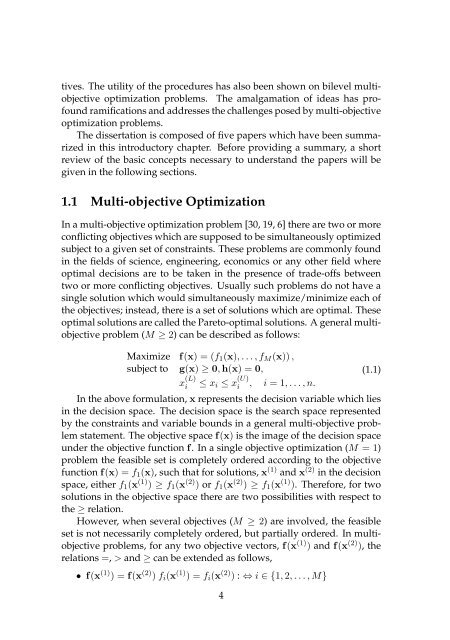Progressively Interactive Evolutionary Multi-Objective Optimization ...
Progressively Interactive Evolutionary Multi-Objective Optimization ...
Progressively Interactive Evolutionary Multi-Objective Optimization ...
You also want an ePaper? Increase the reach of your titles
YUMPU automatically turns print PDFs into web optimized ePapers that Google loves.
tives. The utility of the procedures has also been shown on bilevel multiobjective<br />
optimization problems. The amalgamation of ideas has profound<br />
ramifications and addresses the challenges posed by multi-objective<br />
optimization problems.<br />
The dissertation is composed of five papers which have been summarized<br />
in this introductory chapter. Before providing a summary, a short<br />
review of the basic concepts necessary to understand the papers will be<br />
given in the following sections.<br />
1.1 <strong>Multi</strong>-objective <strong>Optimization</strong><br />
In a multi-objective optimization problem [30, 19, 6] there are two or more<br />
conflicting objectives which are supposed to be simultaneously optimized<br />
subject to a given set of constraints. These problems are commonly found<br />
in the fields of science, engineering, economics or any other field where<br />
optimal decisions are to be taken in the presence of trade-offs between<br />
two or more conflicting objectives. Usually such problems do not have a<br />
single solution which would simultaneously maximize/minimize each of<br />
the objectives; instead, there is a set of solutions which are optimal. These<br />
optimal solutions are called the Pareto-optimal solutions. A general multiobjective<br />
problem (M ≥ 2) can be described as follows:<br />
Maximize f(x) = (f1(x), . . . , fM(x)) ,<br />
subject to g(x) ≥ 0, h(x) = 0,<br />
x (L)<br />
i<br />
≤ xi ≤ x (U)<br />
i , i = 1, . . . , n.<br />
(1.1)<br />
In the above formulation, x represents the decision variable which lies<br />
in the decision space. The decision space is the search space represented<br />
by the constraints and variable bounds in a general multi-objective problem<br />
statement. The objective space f(x) is the image of the decision space<br />
under the objective function f. In a single objective optimization (M = 1)<br />
problem the feasible set is completely ordered according to the objective<br />
function f(x) = f1(x), such that for solutions, x (1) and x (2) in the decision<br />
space, either f1(x (1) ) ≥ f1(x (2) ) or f1(x (2) ) ≥ f1(x (1) ). Therefore, for two<br />
solutions in the objective space there are two possibilities with respect to<br />
the ≥ relation.<br />
However, when several objectives (M ≥ 2) are involved, the feasible<br />
set is not necessarily completely ordered, but partially ordered. In multiobjective<br />
problems, for any two objective vectors, f(x (1) ) and f(x (2) ), the<br />
relations =, > and ≥ can be extended as follows,<br />
• f(x (1) ) = f(x (2) ) fi(x (1) ) = fi(x (2) ) : ⇔ i ∈ {1, 2, . . . , M}<br />
4
















